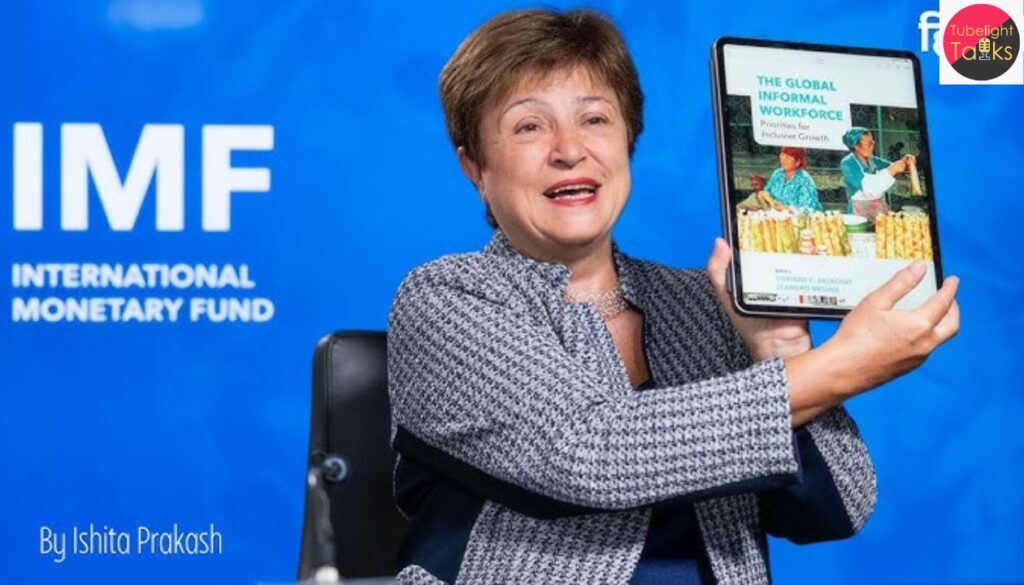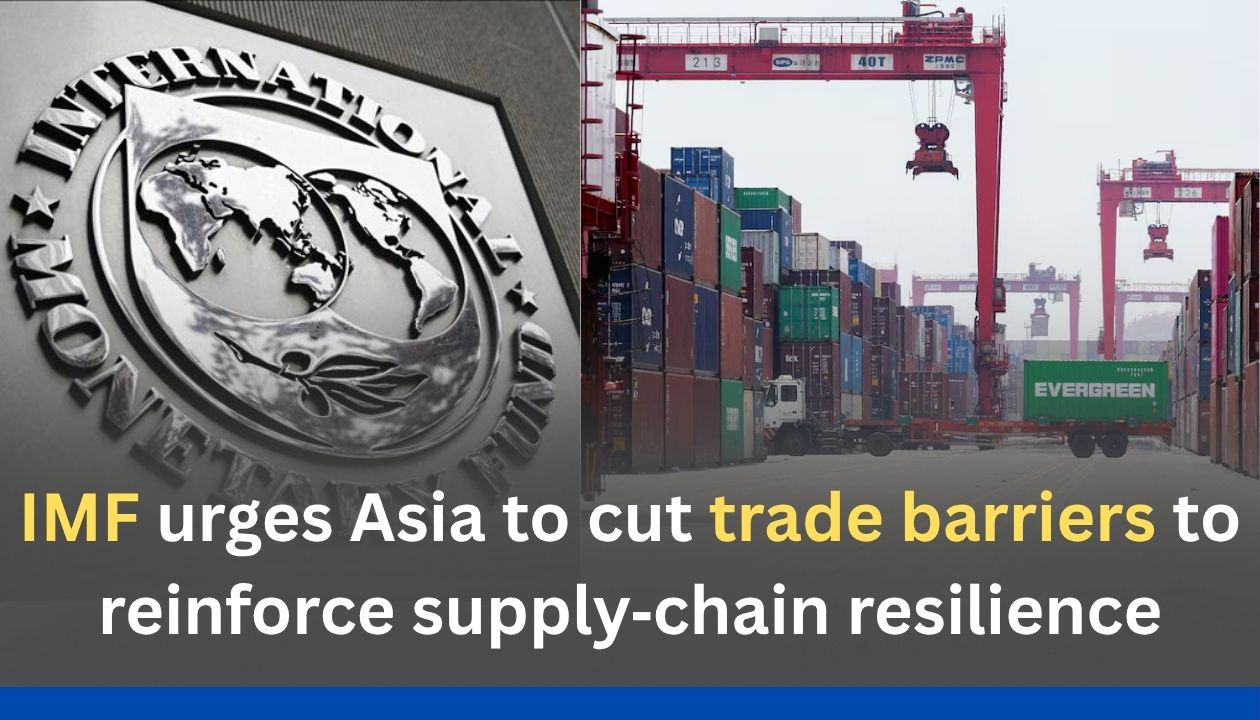Trade barriers: In its latest Asia‑Pacific Regional Economic Outlook, the IMF has urged countries across the region to reduce non‑tariff barriers and strengthen intra‑regional trade as a defence mechanism against growing external shocks — including US tariff actions and global supply‑chain instability. The report underscores that while Asia remains central to global production networks, its heavy dependency on external markets and critical links in supply chains make it vulnerable to policy shifts and trade disruptions.
Vulnerabilities in Asia’s Trade & Supply Chains
Deep‑Integrated Production, Shallow Regional Final‑Goods Trade
According to IMF Director for Asia and Pacific, Krishna Srinivasan, about 60 % of Asia’s total exports in intermediate goods stay within the region. By contrast, only about 30 % of final goods trade remains intra‑Asian. This gap signals reliance on Western final‑market demand and exposes the region to external shocks.
Tariff Pressures & Policy Uncertainty
The IMF report highlights that Asian exporters recently front‑loaded shipments ahead of anticipated US tariff increases, a sign of stress in the system. Growth in the region is projected at 4.5 % for 2025, but could slow to 4.1 % in 2026 if trade‑policy uncertainty and global demand weaken.
Non‑Tariff Barriers as Hidden Obstacles
Non‑tariff measures — such as licensing, standards, local‑content requirements and export‑controls — have surged in Asia since the pandemic.
The IMF identifies lowering these as a key lever to boost trade and resilience.
Why the Call to Lower Trade Barriers Matters
Diversification for Resilience
By reducing trade‑barriers and deepening regional value chains, Asian countries can reduce dependence on any one external market or supply‑chain corridor and thus buffer against external shocks such as tariffs, geopolitical disputes or transportation disruptions.
Cost‑Reduction & Efficiency Gains
Lowering non‑tariff trade barriers tends to reduce transaction costs, accelerate movement of intermediate goods and allow firms to compete more effectively in dynamic global markets.
Unlocking Growth Potential
The IMF estimates that deeper regional integration could raise Asia’s GDP by up to 1.4 % over the medium term, and for ASEAN economies the boost could reach as much as 4 %.

Regional Implications and National Responses
Impacts for Major Asian Economies
Countries such as China — the hub for global supply chains — are vulnerable due to being entrenched in intermediate‑goods flows, while final‑goods trade remains dependent on advanced‑economy demand. This structure may increasingly be tested by supply disruptions and trade policy upheavals.
Smaller and Emerging Economies’ Opportunity
For many Southeast Asian and South Asian economies, the drive to deepen intra‑regional trade presents an opportunity: they can plug into shifting supply chains, attract investment and move up the value chain if trade‑barriers are removed and infrastructure strengthened.
Also Read: Asia Faces Trade Barrier Test as Supply Chains Come Under Pressure
Challenges in Implementation
Despite the case made by the IMF, actual policy change can be difficult. Coordinating regional trade agreements, aligning standards, securing cross‑border infrastructure and reforming domestic regulations all take time. Firms will also need to adjust sourcing and production accordingly.
A Closer Look at Supply‑Chain Risks
Tariff Shock and Production Shifts
As US‑China tensions intensify, many companies are already shifting production toward “China +1” hubs in Southeast Asia. But this transition is costly and slow, making the region still vulnerable to policy reversals or transportation blockages.
Also Read: Trump and Xi set for South Korea summit in bid to ease US‑China trade standoff
Logistics Disruptions and Input‑Shortages
Global supply‑chains face repeated interruptions: shipping delays, port congestion, semiconductor shortages and energy‑price shocks. For Asian exporters heavily embedded in these chains, any break‑point upstream will ripple downstream.
Finance, Standards and Infrastructure Gaps
Many Asian economies still grapple with inadequate trade logistics, border inefficiencies and high trade‑costs — non‑tariff barriers often reflect these structural obstacles. Reform in these areas is integral to lowering trade‑barriers in practice.
A Framework of True Progress
In the context of satgyan — the true knowledge enunciated by Sant Rampal Ji Maharaj — this moment in Asia’s trade landscape invites deeper reflection. As global supply‑chains strain and nations respond with tariffs or barriers, the teaching emphasises that genuine strength lies not just in rugged productivity or geopolitical advantages, but in collaboration, ethical action and inclusive growth. When trade‑barriers fall, it must not only open markets, but also uplift communities, enhance livelihoods and improve resilience for all participants — not just a few. In this sense, trade policy becomes a service to humanity, not merely a strategic lever.
What to Watch in the Coming Period
Policy Moves on Non‑Tariff Barriers
Which Asian governments will announce tangible regulatory reforms — simplified standards, cross‑border facilitation, digital trade rules — in response to the IMF’s call?
Regional Trade Agreement Activity
Renewed activity in regional frameworks such as RCEP or new Asia‑centric trade pacts could signal momentum toward deeper integration.
Corporate & Supply‑Chain Adjustments
Are firms accelerating production shifts, sourcing diversification or building inventory buffers in Asia? Lead‑indicators might emerge in shipping, trade‑data or investment flows.
Economic Growth & Shock Absorption
Will Asia manage to hold growth above 4 % in 2026 despite headwinds? The ability to absorb shocks will test whether trade‑policy reform is delivering resilience.
FAQs: IMF’s Trade‑Barrier Advisory to Asia
Q1. What did the IMF advise Asian nations?
The IMF urged Asian countries to reduce non‑tariff trade barriers, deepen intra‑regional trade, and reduce reliance on external markets to build supply‑chain resilience.
Q2. Why is the region vulnerable?
Because while Asia handles about 60 % of its intermediate‑goods trade internally, only about 30 % of final goods trade remains within the region — exposing it to external demand shocks and bottlenecks.
Q3. What are non‑tariff barriers?
They include licensing, standards, local‑content requirements, border procedures and other regulatory measures that increase cost and delay goods movement even when nominal tariffs are low.
Q4. How much potential gain is there?
The IMF estimates that with deeper regional integration and lower barriers, Asia could see GDP gains up to around 1.4 % over the medium term, and ASEAN economies up to about 4 %.
Q5. What are the main risks if no action is taken?
Asia risks slower growth, higher trade‑costs, increased supply‑chain disruptions and greater vulnerability to global shocks such as tariffs, logistical breakdowns or trade‑policy shifts.










